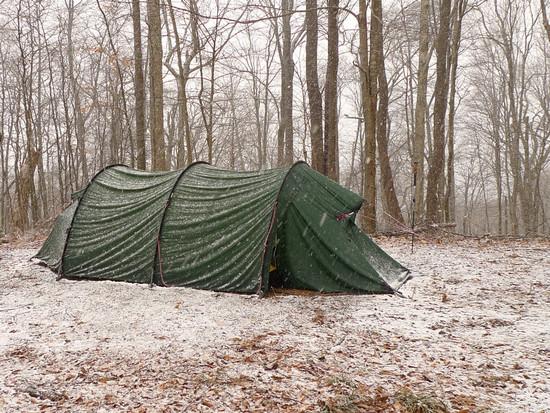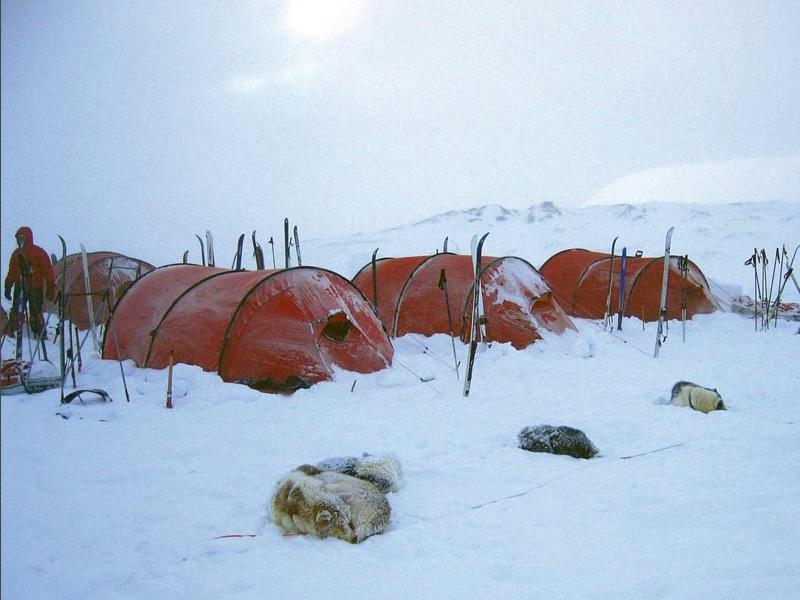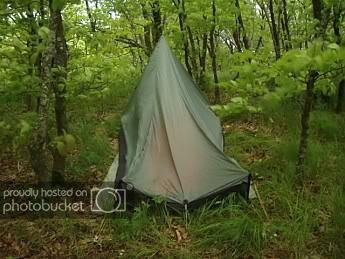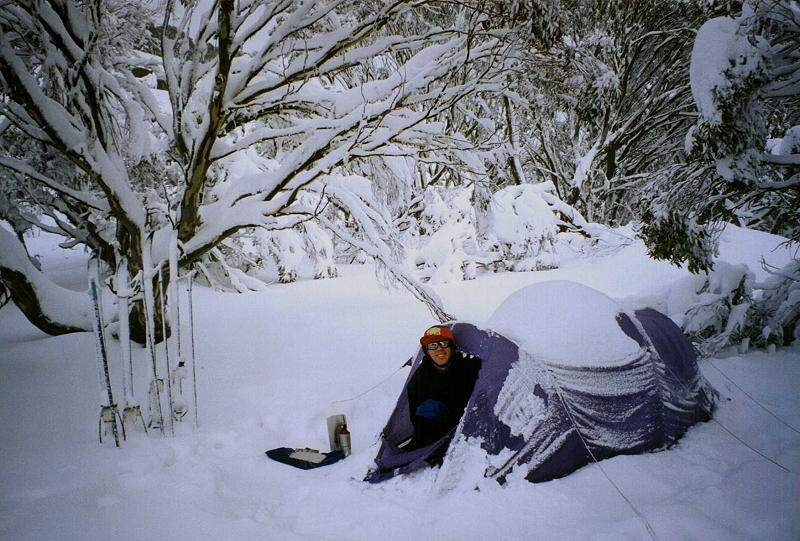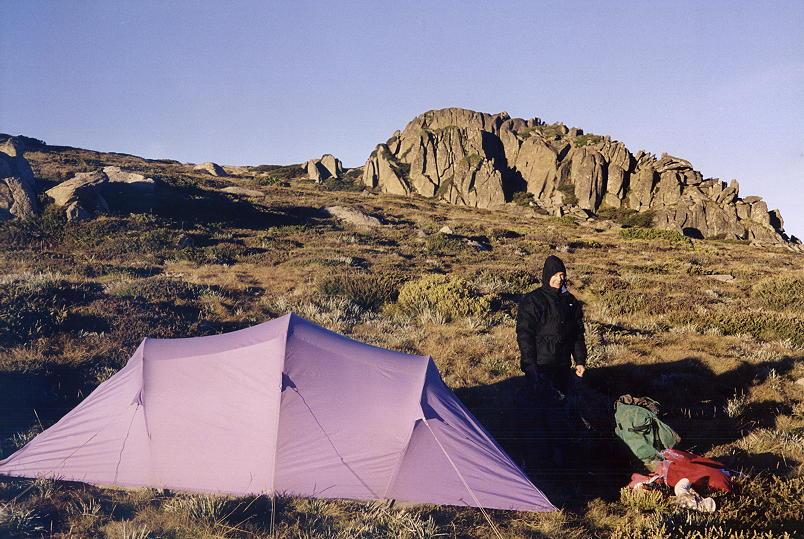Topic
Why few freestanding Cuben Tents?
Forum Posting
A Membership is required to post in the forums. Login or become a member to post in the member forums!
Home › Forums › Gear Forums › Gear (General) › Why few freestanding Cuben Tents?
- This topic has 113 replies, 11 voices, and was last updated 5 years ago by
 Sam Farrington.
Sam Farrington.
-
AuthorPosts
-
Feb 10, 2020 at 11:07 am #3630707
Not sure if it’s been mentioned in this thread, but Big Sky International still makes a few DCF, freestanding tents:
http://bigskyproducts.com/big-sky-international-tents-and-shelters-cubic-fabric.aspx
I think it simply comes down to cost and complexity to manufacture, in a small niche market. On the plus side, all the materials are pretty readily available for the intrepid MYOG’er! I’ll make any shelter desired if someone else funds it :)
Feb 11, 2020 at 12:04 am #3630776Thanks, Eric. Did not know Big Sky was doing DCF. There was a good thread recently about its nylon tents which were impressive (Chinook and some others). But for the DCF Mirage, the link states that orders are closed for this year (2012?). The DCF Wisp is a bit larger than the similar REI tent that is discussed on this page of the gear forum, is around half the weight, and with the DCF would accumulate less condensation than the REI tent, both tents being single wall. BUT the price of $600 is steep, and the photo showing a lot of wrinkling and lack of tautness in the DCF is a caution. You’d expect their own photo would show a taut tent if it could be pitched that way.
Roger, re: “The silicone coating IS porous to water. I can SEE the water getting into the threads under pressure in my HH tester.”
Well so is PU, if my sagging older tents were any indication. Certainly when drops are forming at over 3K HH the silnylon has been penetrated. But not sure how you can see water penetrating at 3K HH, when drops don’t form until 5-6K HH with the 1.06 oz silnylon from Extrem Textil. Since I sent and you tested that fabric, perhaps you can comment. I’m wondering more if the water vapor that condenses on the inside of a tent wall also penetrates through the silnyon to the threads. But that doesn’t explain why my tautly stretched test samples set between the glass and outer window screens develop wrinkles, even though the rain does not strike them directly. Is there a lot more water vapor in the air when it’s raining or humid? Maybe that’s it, and if so, there is nothing for it.
But the good news is that I put some lengths of knitting needle (plastic with a music wire core) criss-crossed diagonally to the fabric grain, and slightly bowed underneath the fabric test loops in dry weather. When wet or humid weather arrived, the fabric stretched in the loops remained taut on most of its surface, except around the inner perimeter of the loops. So am thinking that the death of sagging silnylon may be at hand with the right tent design, including the shock corded stake loops on the downwind side. That only works of course if the tent is designed so that elastic tension on the downwind side affects the whole tent, as is the case with your tunnels.
Only remaining problems are: The slight increase in weight of the nylon over DCF to insure durability, regardless of what one thinks about durability of DCF, and 2) The slight increase in weight of a dome’s pole structure in a design that stretches the fabric on the diagonal.
I think those weight increases can be kept to less than 8 oz; so all depends on whether that is too much extra weight for some to accept vs a DCF dome. With the drawbacks of DCF discussed on this thread, I think it is no contest, but others may not agree.
Feb 11, 2020 at 12:25 am #3630777But not sure how you can see water penetrating at 3K HH,
Sit there with magnification and strong lighting on the fabric as it is pressurised. I can see the threads getting wet. The PU coating on the other side did not leak.Now, it is possible this was a poor quality silicone polymer and a poorly done coating to boot. That is possible. But you have to take this in the context that we KNOW from lab testing that silicone polymer is micro-porous and slightly water-soluble. Yeah, really! Of course, with a good silicone polymer, it might take years for there to be any visible effect.
Cheers
Feb 11, 2020 at 12:42 am #3630778Roger, you haven’t explained why the tautly stretched silnylon, as well as sil/PU nylon, wrinkles up in rainy or increasingly humid weather, when there is no water even touching it. And as was noted, I recall PU coated tents sagging in rain or humid weather. But do not question that you saw the threads getting wet in your HH tester.
Sorry about no pictures, but had problems with the editing, and it is way past my bedtime here in the land of the free. When the tent is done, there will be pictures aplenty.
Feb 11, 2020 at 1:24 am #3630780Behaviour of nylon under cold and wet conditions
================================================
Water molecules get into the molecular structure of nylon and slightly disrupt the bond angles, causing the molecules themselves to ‘stretch’ and weaken. The material also gets a bit more slippery. Moving up in scale, this eventually means that the fibres in a thread will stretch and weaken under cold/wet conditions. But this is fully reversible.You can test this. Take a long narrow (20 mm?) strip of nylon fabric, dry it carefully (NOT over 100 C!), and hang it up with a weight on the end. Then spray it with water on a cold night. It will stretch.
I did measure this many years ago using fluoro brickies string hanging from the verandah roof with a brick on the end. It was educational, and anyone can do the test. This is why I do not use nylon guy ropes any more. They slacken off in bad weather.To keep the actual tent fabric tight in my tunnels, I use bungee cord in two different places. There are bungee cords pulling the pole sleeves tight at each pole end. This is cross-ways tension. There are fairly strong bungee cords at the lee corners to stretch the roof out tightly, lengthways. You may have noticed that my photos of my tents always show the fabric taut: this is deliberate.
Cheers
Feb 11, 2020 at 5:16 am #3630786Yeah, well, the water vapour in air is different from water itself. One is a gas and the other a liquid. The water vapour can penetrate a lot of things and is polar. As such it will find a way to stick and penetrate a lot, if not most, molecular chains where it has the effect of “stretching” them out a bit…more of changing the angle that the carbon/hydrogen normally sits at in a fully dry fabric. This leads to stretching whether or not liquid water is actually on the material. 0
Feb 11, 2020 at 10:27 pm #3630903Thank you, Roger and James. As was already admitted, I’m not the chemist my dad was.
My concern about what may seem irrelevant stems from the focus of this thread; namely the feasibility of freestanding DCF domes, meaning stronger and lighter domes that do not sag. One of the key reasons folks are leery of nylon domes is suggested by pictures like this one:
Despite DCF’s drawbacks, there is none of that, plus less weight. Polyester fabrics also have much less sag, but for equivalent strength and durability there is a substantial weight penalty.
And there is some confusion reflected on BPL forums about the distinction between the benefits of nylon’s elasticity and the curses of sagging like that in the photo above. In order to address that sagging, we need to know more about what causes it, and how it can be addressed, if at all; otherwise, I fear that folks will shy away from nylon and choose DCF or polyester, even at much greater expense and less durability.
There are reports of several tent companies switching to polyester for just this reason; but I’ve not found much about strength for weight in polyester tent fabrics compared with nylon. However, I do have a Snow Peak 4 season dome with a polyester fly fabric that the company made in Japan because they felt the quality of the polyester tent fabric on the Asian market was unacceptable. This tells me that there are substantial differences in degrees of strength for weight among polyester fabrics, but the years fly by, and not much more is known, or at least shared by those who do know.
At this point, I’m inclined to go ahead with the lighter nylons now available, but with designs that will address sag like that shown above; realizing, however, that DCF may have improved greatly (look at the HH specs on some of TarpTent’s DCF tents), and that stronger and more durable polyesters (with their resistance to sag) may be right around the corner. So it is a conundrum. Would like to be able to have a better answer for myself and for the OP, but don’t have it yet.
Feb 11, 2020 at 10:57 pm #3630905Might a possible solution, or at least partial solution, to the wrinkle/crease holes in DCF be to use a large volume pack and just loosely “stuff” the shelter on top of the other contents rather than rolling or stuffing tightly? The weight penalty for an extra 6″-12″ of nothing but UL pack material at the top has got to be less than the weight savings of using DCF for a tent, not to mention the incomparable strength of DCF in extreme weather.
Feb 11, 2020 at 11:55 pm #3630907One of the key reasons folks are leery of nylon domes is suggested by pictures like this one:
Never blame the gear when it is a user fault.Obviously I do not know who owns this tent or who pitched it, but I will make the bald and blunt statement that whoever pitched that tent simply did not know what they were doing – or had brought the wrong poles (see below).
Furthermore, I will also claim that if I had been pitching this tent, it would be taut and sleek, subject to the following problem.
Looking more closely at the tent, I have to ask whether the poles really belong to that tent, or whether the poles have been dug deeply into the ground rather than being properly socketed into the pole eyelets. There is just not enough pole for the sleeve.
I suspect the tent is a Hilleberg Keron3 – a nice simple tunnel, which properly pitched should look like one of these:

You will note that the fabric is taut in each tent.Cheers
Feb 12, 2020 at 2:21 am #3630914“Obviously I do not know who owns this tent or who pitched it”
I do…
the same person that splashed this photo on several forums, multiple times, to “prove” how bad certain shelters are

when in fact he told the world that neither him nor his mate , the owner of the tent, had a clue on how to pitch that shelter.
Feb 12, 2020 at 2:30 am #3630915To demonstrate how difficult that TT shelter is to set up, here is me doing it in 50 seconds

(all in good fun…)Feb 12, 2020 at 3:36 am #3630917Darwin Award.
Cheers
Feb 13, 2020 at 12:30 am #3631050The picture posted above was an old one lifted from the BPL forums as a good example of tent sag; but I’ve seen tents pictured on BPL that were almost as bad. From a number of photos on BPL that have shown tents in real life, I thought the above picture would be representative. But perhaps not.
So, another picture from real life:
Note that the front of the tent, to the right of the photo, is beginning to wrinkle a bit; however the side of the tent, to the left, remains taut. This is partly because underneath the portion of the fly between the guy-out patches, there is a spreader strut that keeps the poles apart. The guy-lines also help with this, as does the shock corded stake loop at the front of the tent.But look at what happens in a photo taken just after a long rainstorm:
The front of the tent develops a lot more wrinkles over an area that is mostly the vestibule cover, an area contacted when going in or out of the tent. Note that the tent fabric is 15D PU coated nylon. Silnylon might have been more wrinkled, especially if the increase in humidity were greater, which is not uncommon.Well designed DCF and polyester tents don’t have this problem. They can’t really, because many are not domes with frames to support the fabric, and the tent walls run straight from the peaks to the ground without additional support. If they were to sag, living space in the tent would be greatly diminished, and really uncomfortable if the tent were a single wall, as many are.
So while domes supported by frames do limit nylon sagging somewhat, non-sagging DCF tents are likely to appeal to many who have suffered under sagging walls, and there is a temptation to address this with DCF or polyester fabric. As noted earlier, from testing I think that with a nylon tent, a design that uses crossed poles to bow out the fabric on the bias, or diagonally across the grain, will greatly reduce sagging.
But this does not help with the vestibules, that are not bowed out except on heavier designs like the Hilleberg Soulo; so the best option may be to use polyester fabrics for the vestibules, which means adding about 1/4 oz per sq. yd.; for example, ~1.3 osy polyester vs ~1.o5 osy silnylon fabric, OR, to use DCF as this thread suggests. Maybe polyester could be used just for the non-weight bearing door panel(s) of a dome tent. It’s back to the drawing boards, but will come up with something unless persuaded that DCF is the best option for a frame supported dome.
While there are a few exceptions pointed out on this thread, it doesn’t look now like DCF domes are in the cards, so a design for a sag resistant nylon dome with slightly heavier polyester doors may make the most sense.
Feb 13, 2020 at 1:11 am #3631055@Sam
My own take on the wrinkles in the tent you have posted is that they indicate a fault in the tent design, regardless of the fabric used. The wrinkles are probably not there when the door zip is done up completely; they appear when the support provided by the zip is removed.So, I don’t think you can fix the design fault by changing the fabric.
Cheers
Feb 13, 2020 at 2:45 pm #3631129Feb 13, 2020 at 3:08 pm #3631132Oooh, lots of rocks which makes pitching just as easy.
Feb 13, 2020 at 9:56 pm #3631220Franco,
The second photo was taken just off an old logging track on the side of Long Mountain, which is just above the White Mountain National Forest in northern New Hampshire, a far cry from a nice grass lawn. Not sure why you would pitch a tent at the place shown in your photo. Guess I’m a little more choosy about where to pitch.The first picture, as you say, was of a pitch on the back lawn. It was chosen just for the better view of the side of the tent. Anyway, here’s the same tent pitched off trail on the side of Mount Washington. Was just looking for a windy spot to see how it would hold up. But no, I wouldn’t spend the night there either:
Feb 13, 2020 at 10:06 pm #3631226Oops, thought Brad’s photo was from Franco. Sorry about that.
Roger,
OK, Now I get it. All issues with silnylon tents are the fault of the user. But you’ve driven me to stop hinting and reveal that the second most wrinkly tunnel I’ve seen was in a photo in one of your posts or articles. I think it may have been from a trip you and Sue took to the European Alps.Feb 13, 2020 at 11:32 pm #3631233All issues with silnylon tents are the fault of the user.
NO! I said the wrinkles in the pop-up were a design fault, NOT a user fault. I stand by that statement.the second most wrinkly tunnel I’ve seen was in a photo in one of your posts or articles. I think it may have been from a trip you and Sue took to the European Alps.
Been a lot of those trips over the years. Can you be more precise? URL? I am curious.As to where one pitches the tent – sometimes the choices are kinda limited. Like my tent on the large flat rock in Windy Creek. To my mind, the only hard requirement for pitching any of my tunnels is the need for reasonable anchors for the two pegs at each end. I have yet to find a place where it has not been possible (subject to a bit of scouting around of course).
Cheers
Feb 16, 2020 at 10:32 pm #3631684Hi Roger,
Sorry you took me literally, and my attempt at humor fizzled.
Only for you would I rummage through BPL’s archives to try to find that wrinkly picture. When there is time, will most certainly do so.
I’ve never had a hard time finding a place to pitch, so long as I started looking well before dinner time. If not, ended up once on a railroad bed. Like to think I’d sense enough that it was abandoned, but memory has faded.Here are Zpacks specs for a .55 oz DCF used on its pocket tarp:
Tensile Strength: 63 lb/in (552 N/5cm)
Puncture Strength: 1.8 lb (8 N)
Water Resistance: 15,000 mmH₂O
And they are quick to point out no concerns about exposure to DWR chemicals.
Any comments?Back on piste, finally realized that in order to bring the weight of a freestanding design down to acceptable limits would have to go to DCF, or change the structure of the carbon pole framework a bit, to bring down the total fabric area. Since the old I.Q. is not much above average, and falling fast, need to make some readily adjustable scale (6:1, with music wire poles) models to accomplish this. But am not overly concerned, because space will still be ample compared to the lighter offerings of the cottage companies. Would like to find a pole configuration that with a side entry allows a 2-peg front vestibule, and a 1-peg rear vestibule for pitching in high winds, as your tents do. So as I posted, back to the drawing boards.
Feb 16, 2020 at 11:40 pm #3631690Hi Sam
That’s the problem with ‘internet’ interactions: you can’t see whether the OP is grinning or not. I have the problem in both directions.
DCF: I just don’t trust it or use it.
The bit I do question is the idea that one should set a target weight for something as vital as a tent and then keep compromising reliability or function to reach that target. I suggest the opposite approach: pick the best materials for the job – pick a good design, use light-weight silnylon fabric (maybe not UL), carbon fibre poles, Spectra/Dacron string, etc, and accept the resulting weight. It may not be as low as the glamorous but failure-prone DCF, but you will sleep more securely in a storm.
Storms: we got 200 mm (8″) of rain in under 48 hours here recently, along with tornado-force winds (which flipped one of our horse sheds upside down). Quite OK in one of my tunnels (assuming a drained site!), but I want to see someone manage a that in a single-pole DCF pop-up or in a bivy.
A 1-peg rear end into the wind is not to my taste: I want two or three good pegs at that end. My 2c.
Cheers
Feb 16, 2020 at 11:53 pm #3631691Floppy tunnel tent pitches: heresy!
But now I come to think of it, I do have a photo of a floppy tunnel tent pitch from long long ago. This is a Macpac Olympus tent, one of the finest commercial tunnels on the market. It is also an old model.
Bad storm in late afternoon, we could see maybe 2 – 3 metres ahead. Eventually we decided that where ever we were was probably not where we wanted to be, and since there were some snow gums here offering a small bit of shelter, we would stop and camp. Of course, everything got caked with snow overnight, and the guy ropes and tent fabric went loose and floppy, as you can see.
The thing is, that was when I was still learning about fabrics and strings in the cold/wet. We had fun anyhow, but when we came home I started to research about nylon fabric and string, doing experiments at home. The Olympus did not have bungee cords loops at either end for tensioning when I bought it, but I fitted them shortly after this (lee end ONLY). Subsequent pitches were much better.

Sub-zero this morning, with sheet ice in the creeks. Sue in a down jacket (me too) – needed.
We all have to learn sometime. Just make sure you keep the receipts.
Cheers
Feb 17, 2020 at 6:02 am #3631700The most efficient tent designs are semispherical, least surface area for internal volume.
The most efficient solo tent is rectangular about 18sqft/1.67sqm and about 43-45″/around 1.25m high.
Now comes the fun. Designing a compromise between the two shapes, using trekking poles to hold a tent up, making it storm worthy, adding storage space, and so on, will bring about the largest compromises in tent designs. Have fun Sam!
Feb 17, 2020 at 2:35 pm #3631744Better add avoiding any hint of a flat top which could collect rain or snow.
Cheers
Feb 17, 2020 at 6:02 pm #3631824Hi Roger,
Floppy can result from stake failure, or failure of anything else that holds the tent up and in place. But when I mentioned ‘saggy,’ was thinking about a tent pitched taut, but after moisture & humidity, wrinkling badly. So much so that with heavy winds, the moisture gets into everything and everyone, not to mention the frightful racket. You could call it ‘the monsoon effect.’ So, sagging and wrinkling must be minimized. It’s either that, polyester, or DCF, at present AFAIK.You have some great approaches to the minimizing and I’ve also had some success with testing nylon pitched over a frame that expands the fabric more on the bias. Since nylon is heavy enough already, and even though polyester absorbs less moisture and sags less, am not enthused with polyester, because of the added weight needed to get strength equivalent to nylon.
As for DCF, have reread a long thread begun by Gary Pikovsky, ‘We have the next cuben fiber and it’s amazing!’ Get this, he wasn’t talking about DCF; rather the nylon on his GG tent. There are a couple 2016 posts in there from Ross Bleakney and Nick Gatel, who I believe are long time trekkers, attesting to the durability of their DCF tents. But turning to another thread, ‘Tarptent Notch Lithium,’ there is a Feb 2018 post from you that sheds doubt, ‘as the panels on a tunnel need to stretch a bit when it is erected.’ And the bonding produces seams that are ‘rather stiff.’ You also note that a couple others who used DCF on tunnels had similar experiences. Certainly agree about stiff seams ruining the function of a tent, not to mention packability.
So while your tunnels are not exactly like the ‘freestanding’ tents I like, they both rely on tension on the canopies to keep them taut, as do most small tents, I expect. So I think we have the same dilemma, albeit you have built a ton more tents than I have from scratch, and most of mine have been mods.
The only difference in our approaches may be that I spend more time thinking of ways to reduce weight, just so long as the shelter will also be adequate for my needs; and that includes durability, quick pitching and striking, dryness inside (although some say ‘bone dry’ cannot be achieved), snow shedding, and most important, wind shedding. I know that there are times and places in the Presidential range in NH when one cannot stand up, and some may want a shelter that can tolerate just about anything. That is OK if you are willing to carry more weight. Not having encountered conditions that extreme with no ability to retreat to more sheltered terrain, I’ve not been willing to carry the extra weight for a ‘bomb proof’ tent.
That may have been a factor in the OP’s attraction to DCF ‘freestanding’ tents; but I think that anyone wanting to backpack a shelter that can withstand just about anything is due for a disappointment, any maybe a fatal one. Don’t think trekking tents are made for monsoons and hurricanes.
It sounds like you folks down under have been having a rough time. Your weather has been on Public TV news all the time. When you get tornado force winds, I hope you will head for a storm cellar or the like, not for a tent; tunnel, DCF or otherwise. Isn’t backpacking supposed to be a form of recreation?
-
AuthorPosts
- You must be logged in to reply to this topic.
Forum Posting
A Membership is required to post in the forums. Login or become a member to post in the member forums!
Trail Days Online! 2025 is this week:
Thursday, February 27 through Saturday, March 1 - Registration is Free.
Our Community Posts are Moderated
Backpacking Light community posts are moderated and here to foster helpful and positive discussions about lightweight backpacking. Please be mindful of our values and boundaries and review our Community Guidelines prior to posting.
Get the Newsletter
Gear Research & Discovery Tools
- Browse our curated Gear Shop
- See the latest Gear Deals and Sales
- Our Recommendations
- Search for Gear on Sale with the Gear Finder
- Used Gear Swap
- Member Gear Reviews and BPL Gear Review Articles
- Browse by Gear Type or Brand.

